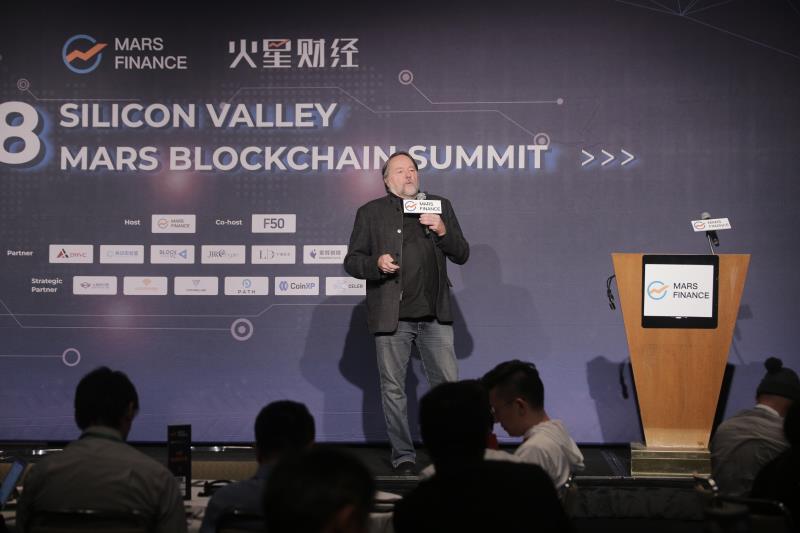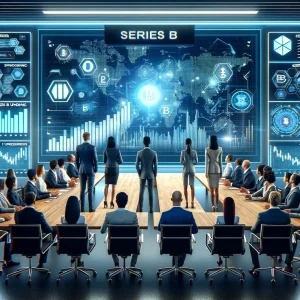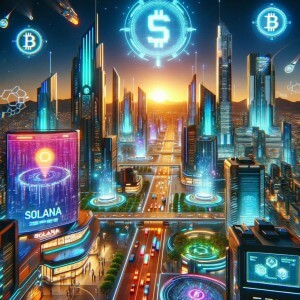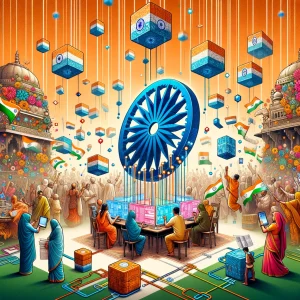Reese Jones might be one of the most forward thinking people you’ll ever meet. And by forward, I mean thousands of years into the future, where blockchain and computing might be integrated into every aspect of life, even into matter itself.
Jones has a resume that would intimidate any CEO. He is an Associate Founder and Board Trustee at Singularity University, an advisor at Facebook, the founder and chairman of Cambrian Genomics, a Board Trustee of Sante Fe Institute, and is on the Genetics Advisory Council of Harvard Medical School, among many others. After studying as graduate student in biophysics at Berkeley, he created several companies and developed many patents and move into Venture Capital. He trained and worked as a biophysicist working on projects like. He’s a regular speaker on the topics of genetics and technology and is currently working on projects focused in his interest in human evolution. What he has to say about blockchain could impact everything in our future.
(Q) How is the blockchain going to evolve? Do you see blockchain as a natural evolution of information and technology?
(A) There are two important insights that the biological model would give you about blockchain.
Number one is: There is likely to be many different kinds of blockchains in the future as opposed to one primary blockchain. This is“diversity”, like in biology.
The second is: blockchains right now save all of the data. DNA and genetics throws away a lot of data, because it is too costly to save everything. It’s technically possible, but there’s no survival value in saving every little piece of data.
(Q) Isn’t most of our DNA made of“junk” DNA?
(A) Well there’s a lot of theoretical reasons why that’s there, and it varies across different species, some have more junk and others have less, and part of it has to do with how the DNA is folded into chromosomes and which things are sticking out at which time. So the junk isn’t necessarily junk, any more than walls are junk compared to doors.
But the other reason to have “junk” is that DNA in biology is attacked by parasites all the time, bio-hackers, viruses that attack the cells and actually put themselves in the DNA, like a hacker would get inside your computer. If you space out the useful genes within the intermediate junk, the probability of the virus inserting itself into junk is much higher, 10x higher, then into an actual gene where it would hurt the metabolism and hurt the code. You actually want to add in some junk as landing strips for the bad actors. That may be what happens in blockchain too and in computer security.
If you look at the average genome, a good portion of it, at least half functions as its immune system. Crisper is the immune system for microbes. It’s the memory and the immune system. A lot of DNA in biology is reserved for immune response and defense, repairing from damage that is often caused by parasites. That’s about half the operating system of the genes, the DNA of a human. If you look at what portion of the operating system of Apple or Windows is devoted to virus defense and repair, it’s 1% at most.
It would suggest that there is a lot of room for growth for adding security and defensive detection and repair into our systems that hasn’t been done yet, but it’ll make more survivable software based things. One of the defense mechanisms is adding junk in there.
(Q) Or maybe in the case of blockchain like Bitcoin, adding redundancy through proof of work, something to make it difficult to change things.
(A) There are perhaps 100 different ways to validate and replicate blockchains, and proof of work is one. Proof of stake is another. There are many others. Each one has more or less resources that are required to do it. The proof of work technique consumes a lot of compute power which requires a lot of electricity to run. But that’s an extra defense, like junk DNA, something that makes it much harder to hack.
If someone were to try and change some record in the blockchain, they would not only have to change it and recalculate all of the transactions back to their original block, and that would be changing it on one computer, then they would have to get that on thousands of other computers. That is overwhelmingly difficult, which is why no one has hacked Bitcoin so far.
There are other attacks – 51% attacks and other kinds of vulnerabilities that haven’t been hit yet, but in comparison, every month there is a new vulnerability discovered for Intel chips, which have been around for decades and are in almost everything, including iPhones, and these are vulnerabilities that were there and have just recently been discovered. So it’s a moving target of how a protocol works, what its vulnerabilities are, and how robust it is. Even if you are exploiting the vulnerability, can you deal with the redundancy of things. Bitcoin and blockchain are new in this regard.
People say it must be secure because there is a reward of $200billion if your pocket if you hack it, and you can be pseudo-anonymous, and nobody has hacked it yet in that regard, at least the main blockchain. That is sort of a proof that the security is good. But it doesn’t mean it’s perfect. So where are the vulnerabilities that haven’t been discovered yet? A lot of them are discovered only when something bad happens.
(Q) You talk about an analogy between blockchain and life itself, especially as it relates to our DNA and information storage of DNA and life processes. Where did you first come up with that analogy and was it immediately clear to you or was there some process that took place?
(A)It has evolved over time. I started out in biophysics, I was doing medical research on the differences in people with schizophrenia, biopolar, and their brain chemistry using medical imaging techniques, so we had medical images and MRI images.
These are sort of parallel universes and not many people go back and forth between them, but I do, so the similarities seemed eerily surprising. I’ve been in the biophysics area for a long time and part of that is using mathematical models to simulate real things, and in particular biological things, like how do fertilize eggs turn into fetuses, and how does information flow through cells and bodies and things like that. I spent a long time in information theory modeling. In synthetic biology, you read the DNA out into the computer, and you change it on the computer, and then you write it back into DNA and put it back in the cells, and you run it like software, so you sort of read and write software written in the code of DNA, life. You’re writing programs made out of genes that do things.
It took a while to figure out is DNA a token, to sort it out where a blockchain is more like a species where there is a genome, and lots of different species are all in the same genome. The token is like an individual. In an overly simplified analogy, if the blockchain is the genome, like you’d get at 23 and me, and tokens are individuals, we are tokens of the human genome. And our life is like the life of one bitcoin. What happens to it over time. It’s overly simplified enough so even kids can understand it.
(Q) If we’re the token, then the real value is the individual human being?
(A) Yes, from the point of view of the individual. But from the point of view of the market, it’s what are all the tokens worth.
(Q) Or which direction are they going?
(A) Right. There are issues of consciousness and perception itself, like what does it mean to be alive? When each individual goes through its lifecycle, is that like the leaves of a tree coming out in the Spring and falling off in the Fall? And the tree doesn’t die, each individual leaf dies. The leaves that come back are new leaves, but there is a larger cycle of the blockchain of that tree’s genome, and then there are individual trees, and then there are individual leaves that come and go. If we’re like a leaf or a tree? Our own consciousness has us at the center of what is important, but in the bigger picture, when an individual like you or I dies, maybe like the leaves turning on a tree, the important thing is that the tree survives and whether that species of tree survives, and not necessarily each individual. That’s important. What happens when a species goes extinct? That’s kind of like really dying. Individuals come and go, but as long as they’re coming the species is alive and surviving. These kinds of metaphors are abstract, but interesting to consider.
(Q) With something like Bitcoin, where there are a limited number of tokens that never disappear, there is a form of eternal life, at least of information.
(A) It’s like your digital self. I did a TEDx Talk a while back on Digital Twins – a digital version of your life. If a Bitcoin is like an individual, and it’s going through a life and it moves around, that whole journey is recorded in the blockchain. You can sort of do that using certain techniques in genetics, by looking at when species diverged, and how closely they were related to different species, and that can be pieced together, but in the blockchain, all the information is there and every single adventure that each Bitcoin has taken is recorded.
(Q) An akashic record of value.
(A) In a sense. We are kind of going that way as we put more of our lives on Facebook and our medical records, and our credit report and our spending history, etc. There is a lot more information being saved about us than ever before, and from that information, an AI internet can reconstruct a personality, and with more information, you can reconstruct the personality more accurately. In the future, it may be more difficult to tell if a person has died or not, because their Facebook may still be going on just as they always had been. And the digital twin, our avatar or agent, will keep us going.That may be like this blockchain and token phenomenon, this record of the lifecycle. If someone is born today, there is a pin prick of blood and a footprint, and there is all the information about their genetics, and they are in a database that’s increasingly cross connected for their whole life. The amount of information about a human is becoming increasingly digital. In DNA there are 3 billion base pairs, or letters, which is about1.5GB of data, but today many people have a Facebook profile that is bigger than that, and it’s getting bigger faster. So the amount of data that is a person, is changing to digital and being saved.
(Q) Is that instinct to preserve all of this data about us, is that a natural human instinct, a biological instinct, or a psychological instinct to preserve all of this data?
(A) I think it’s just practical. It would cost more money for all of this compute power to have to erase some of the data rather than to just keep everything. It’s just practically easier for Google and Facebook and amazon to keep all of the data. So just keep everything. If the person wants to be forgotten, as in the right to be forgotten, then you just put a little pointer on the hard drive to say that information isn’t there any more, or at least don’t read it. But it’s still there.
(Q) Where do you hope to see this technology go?
(A) You mentioned AI, and I’m very optimistic about it. The current CEO of Google says that AI is as important to humanity as the discovery of fire and electricity. It’s the 3rd thing on that scale. He and many other people would say that AI will be in everything. Kevin Kelly says that add AI to anything and it makes it better. There’s kind of a natural diffusion into everything getting smarter. Ray Kurzweil writes about something called Computronium, which is how physical matter like a rock turns into a computer that calculates things at the atomic level, so that when matter is able to compute and the universe will wake up. That’s how he puts it.
A quantum computer works on atoms that aren’t moving around and there’s a system measuring their spin and the computation is how does one spin link to another, but at this stage these atoms have to be super frozen and tightly controlled, and that’s closely monitored. But as technology improves, the atoms could be more loosely coupled, like the atoms in a rock, and the way they related to each other might be more distant. The quantum mechanics are happening anyway, that’s how atoms work, but can you use that to perform computations intentionally as opposed to being random. It’s possible that will be invented, and in that case everything becomes a computer.
(Q) How close are we to those kinds of quantum computers?
(A) One would say biological life is already like that. That we are controlling the chemistry of life, and what life is doing is fighting the second law of thermodynamics. Life is almost like negative entropy, and in a sense our function and purpose of life is using and manipulating chemistry to resist this natural phenomenon which in an abstract way requires computation, like how do you combine this molecule with that molecule to make a third thing, and that’s what life is doing. It’s making some calculations using the techniques of chemistry and quantum mechanics, but how that becomes controllable in a computer sense is probably far away, though it’s not impossible. The most powerful computers that the world has today can’t even calculate accurately the quantum mechanical folding of a single protein. There are maybe 1 billion proteins in one neuron, and there are billions or trillions of neurons in our brain, so if a regular computer can’t even calculate one protein, it’s way far away from simulating the brain of a person. These things are orders of magnitude far apart, but with exponential improvements in these things, that gap closes quickly.
Singularity is trying to teach people how exponential technologies work, and it teaches people how to use that to solve problems at scale. And that is getting better every year. Singularity University is the same age as Bitcoin. It started its first program when Bitcoin started trading, and it had its organizational meeting in 2008 when the Bitcoin paper was published by Satoshi. Blockchain is part of the puzzle, but there are other exponential technologies, like memory and compute power and wireless speed, and AI and other things that are part of it.
(Q) Do you see a real difference between nature and technology, or do you see it following the same pattern?
(A) For me I don’t see a major difference. It’s all a kind of information flow across time. Kevin Kelly has a great term for this called the Technium, which is the evolution of complexity, and that there is no distinction of whether that complexity is evolving in electronic form or biochemical form, or some hybrid, like a person holding their phone, but that is all part of the evolution of complexity. Jeffery West of the Santa Fe institute has good theoretical models of how complexity works at different scales, and there is a guy down at Spark who has a theory called the Transcentient hypothesis, which is the answer to Fermi’s paradox of why we don’t see advanced civilizations in space somewhere. If it is a natural thing to evolve, why don’t we see aliens? There is this Transentient hypothesis, that evolution is towards more complexity, but more complexity doesn’t mean more visible. Right now humans beam a lot of rockets and radar and TV out into space, and it’s less efficient and noisy.
(Q) There’s a lot of waste.
(A) Right. We think if everyone is like us that they’d be easy to see. But it may be an evolutionary step to continue evolving going towards more complexity, but going from telecom to fiberoptic, from simple electronics to integrated circuits, from high power to low power, it’s more efficient and the complexity continues but it becomes smaller and quieter and less visible. Perhaps the reason we can’t see advanced civilizations far away, is that they have evolved to be invisible as far as we’re concerned. And they may be extremely complex, but in a virtual world that is all inside densely packed electronics and chemistry.
(Q) Are aliens using blockchain?
(A) Is the information theory about blockchain some natural phenomenon, a meta-phenomenon of how information works, then maybe. The similarities could be surprising. Some strict information theorists get upset about information theory that’s been developed around digital electronics or digital computation, or even mathematical computation, just number theory, where the edges between things are very sharp, like 1 or 0, and not something in between (like .5). But biology and chemistry don’t work that way. Chemistry is intrinsically analog, in that there are a continuum of steps that vary with temperature and vary with randomness, and things are kind of 1, kind of 0, or neither, or something in between. Moving from information theory in the digital world into the analog world, things get sloppier. My experience in doing biophysics, doing both biology stuff and physics stuff, I have friends on both sides, and the physics people tend to be very deterministic, in that things are definitive, true or false, it works or it doesn’t, and that’s how many engineers think and so on. However, biology is non-deterministic – you can kind of see what’s going on, it’s socastic or probabilistic, in that you’re saying I’m 99% sure that it’s this, but I’m not 100% sure. The people who are very analog get upset by these cross overs, and people who are deterministic get uncomfortable around things that are non-deterministic, which also runs into dualists and non-dualists – physicists often are dualists, in that it’s true or false, good or evil, and a lot of people, probably 90% of people are dualistic. As opposed to them being continuums on a chain that is just statistical and probabilistic.
(Q) Do you have a favorite cryptocurrency or token?
(A) For a while my favorite was Ethereum, because people were actually using it for lots of things. But it has less of a robust stability than Bitcoin’s blockchain. It’s already had some problems, like when Crypto Kitties crashed it. And of course the Ethereum gang is working on improving that and there are many good projects to improve those deficiencies. That’s kind of the way technology evolves. You put something out there, you learn in the real world where its deficiencies are and you fix them, as opposed to you sit in an ivory tower and you build this allegedly perfect system, put it out there and some glaring deficiency is discovered quickly. I like these things that are being tested and refined in the real world. Bitcoin’s blockchain is also being brutally tested in the real world. Bitcoin and Ethereum are more than 50% of the market value, and I think they are in more active daily use than any others by far. Those are my 2 favorites and each one has its different reasons. Bitcoin is hard to build things on top of it. Ethereum is easier to build things on top of it, but it’s less stable. But in both cases, a lot of people are using it. People are promoting tokens, there are over 3000 tokens, many of which use Ethereum’s blockchain, but I can’t think of any that have actual commercial traction. Being private removes one of the valuable things about being a blockchain. In a public blockchain, anyone can take a look at it and find a deficiency.
(Q) Are you buying, selling, or Hodling?
(A) A combination of buying and selling. We’re down about 2/3’s. Anyone who has lost 60-70% of their investment is going to be skeptical about putting more in. Many of these things are at the same price as where they were a year ago in August. They’re even or neutral from last year. It may mean that the bubble already happened, it’s deflated, so we’re back in normal mode. We’re in this slow period, slow relative to crypto people’s thinking.
Valuation is difficult. The money that goes to buy a company, that money will go to the shareholders, which are a very few people, not to the token holders. What is the token valuation in that case? That is yet to be established by enough transactions in a market to see what it is. I would guess that in a few years less than 100 cryptocurrencies will remain standing, so it’s about a 95% failure rate. But if you compare that to startups, like Y Combinator, they have a failure rate of about 93%. Expecting less failure rate from unregulated, unfeduciary token based companies, would be optimistic. If you expect 5% surviving after 5 years, that would be about 100 tokens out of 2000 now. Which ones that will be is yet to be seen.





